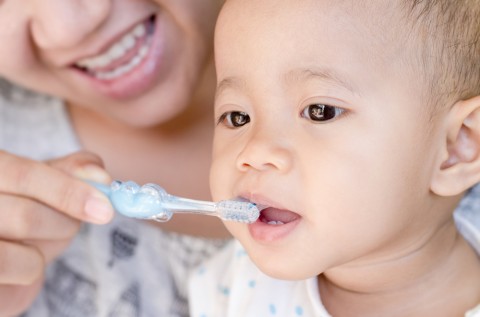No Need to Delay Fluoride for Children
 In many cultures, a baby’s first tooth eruption is a celebrated milestone in their life. Here in the United States, there is usually even a line to mark the occasion in most baby books. But what happens after that first tooth appears can be a little confusing. For years, toothpaste manufacturers have marketed fluoride-free cleansing pastes and gels to help keep those early baby-teeth clean without running the risk of babies ingesting too much fluoride during brushing. But while fluoride-free toothpastes certainly help keep babies and children’s teeth clean, without added fluoride, children using these pastes are missing out on the added protection fluoridated toothpaste provides.
In many cultures, a baby’s first tooth eruption is a celebrated milestone in their life. Here in the United States, there is usually even a line to mark the occasion in most baby books. But what happens after that first tooth appears can be a little confusing. For years, toothpaste manufacturers have marketed fluoride-free cleansing pastes and gels to help keep those early baby-teeth clean without running the risk of babies ingesting too much fluoride during brushing. But while fluoride-free toothpastes certainly help keep babies and children’s teeth clean, without added fluoride, children using these pastes are missing out on the added protection fluoridated toothpaste provides.
Now, thanks to a new report by the American Dental Association’s Council on Scientific Affairs, researchers have found that there really is no benefit to brushing your child’s teeth with fluoride-free toothpaste. Dr. Gary Lederman of Bellmore, New York believes this push to introduce fluoride to younger children comes at a time when tooth decay and cavities in young children is at an all-time high.
"The ADA estimates that more than 16 million American children suffer from untreated tooth decay," said Lederman. "If using fluoride-free pastes or gels in those children was providing adequate protection against cavities and decay, those numbers would be much, much lower."
According to the newest recommendations by the CSA, children should begin using fluoridated toothpaste as soon as their first tooth erupts.
"When brushing an infant’s teeth, we recommend you use a drop of paste only about the size of a grain of rice," said Lederman. "For toddlers over the age of three, we recommend using a pea-sized drop of toothpaste. Over the age of six, it is recommended that you use an adult -sized portion of toothpaste. These guidelines will allow you to use enough toothpaste to get the teeth clean and keep them protected, but not cause fluorosis, a condition which occurs when too much fluoride is swallowed. Teeth with fluorosis may have the appearance of white lines, streaks or spots, and in some cases, may become pitted or have brown, black or gray spots. Teeth with fluorosis may also have misshapen enamel. In addition to closely portioning the amount of fluoride your child receives on his or her toothbrush, Lederman encourages parents and guardians to teach their children to spit out any excess paste after brushing and to rinse with water.
"Of course, no oral health care regime is complete without flossing or visiting the dentist, so make sure you are flossing your children’s teeth as soon as your child has teeth that are touching."
As for the right time to start bringing your child to the dentist, Lederman says children should begin seeing a dentist regularly as soon as they get their first tooth.
"Don’t go by age as a rule of thumb," he said. "Even in the same family, some children may get their first teeth as early as three months of age, while others may not get them until after the age of one. It all depends on the child."



